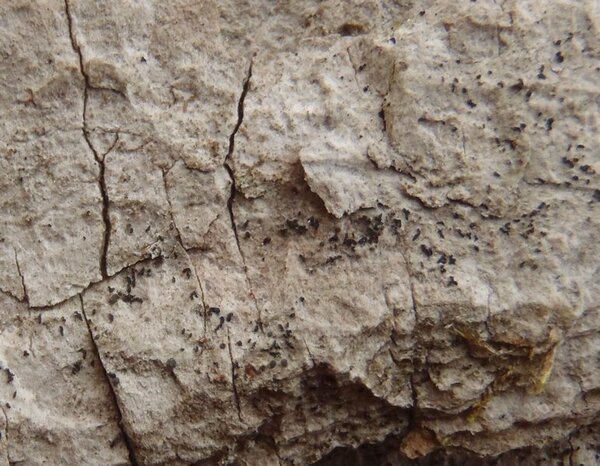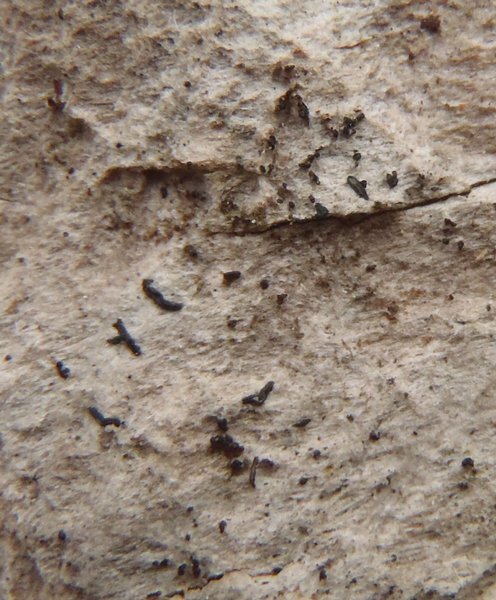Arthonia excipienda (Nyl.) Leight.
Lich. Fl. Gr. Brit.: 393, 1871. Basionym: Arthonia astroidea var. excipienda Nyl. - Not. Sällsk. Fauna. Fl. Fenn., 4: 252, 1859.
Synonyms: Arthonia cytisi var. meridionalis Zahlbr.; Arthonia dispersa var. excipienda (Nyl.) H. Olivier; Arthonia hibernica Nyl.
Distribution: N - TAA (Nascimbene & al. 2007b), Lig (Brunialti & al. 2001). C - Tosc, Umb (Ravera 1999, Ravera & al. 2006), Abr (Caporale & al. 2016), Mol (Caporale & Ravera 2020). S - Camp (Garofalo & al. 2010), Bas (Potenza & al. 2010, 2014), Cal (CLU 16686), Si (Cataldo & Ravera 2013c).
Description: Thallus crustose, endosubstratic and usually poorly evident, sometimes delimited by a dark prothalline line. Apothecia arthonioid, mostly lirelliform, up to 1.5 mm long and 0.3-0.5 mm wide, straight or curved, simple or rarely sparingly branched, with an initially slit-like, later somewhat expanded, brown, epruinose disc, and a slightly raised marginal zone. Proper exciple evident, containing remains of bark cells, 12-40 µm wide, dark brown, the pigment K+ pale green; epithecium pale brown to olive-brown; hymenium colourless, not inspersed with oil droplets, (30-)40-40(-80) µm high, I+ blue; paraphysoids 1-1.5 µm thick, without apical brown caps; hypothecium thin, colourless. Asci 8-spored, broadly clavate, semi-fissitunicate, with a large apical dome and a distinct ocular chamber, Arthonia-type. Ascospores 1-septate, hyaline, ovoid, (14-)15-20(-23) x 5-8(-10) µm. Photobiont absent, but thallus reported to be loosely associated with trentepohlioid and/or chlorococcoid algae. Spot tests: K-, C-, KC-, P-, UV-. Chemistry: without lichen substances. Note: on the smooth bark of deciduous trees and shrubs in riparian montane woodlands; probably overlooked, or confused with Naevia punctiformis. It is included in the Italian red list of epiphytic lichens as “Vulnerable” (Nascimbene & al. 2013c).
Growth form: Fungus
Substrata: bark
Reproductive strategy: mainly sexual
Pioneer species
Commonnes-rarity: (info)
Alpine belt: absent
Subalpine belt: absent
Oromediterranean belt: absent
Montane belt: very rare
Submediterranean belt: extremely rare
Padanian area: absent
Humid submediterranean belt: very rare
Humid mediterranean belt: absent
Dry mediterranean belt: absent

Predictive model
Herbarium samples


Curtis Randall Björk – CC BY-SA 4.0
British Columbia, Coast Ranges, near Bute Inlet. Photographed from specimen (Björk 19763, UBC), on trunk of large Populus trichocarpa in rainforest. 2009-09-04
Growth form: Fungus
Substrata: bark
Reproductive strategy: mainly sexual
Pioneer species
Commonnes-rarity: (info)
Alpine belt: absent
Subalpine belt: absent
Oromediterranean belt: absent
Montane belt: very rare
Submediterranean belt: extremely rare
Padanian area: absent
Humid submediterranean belt: very rare
Humid mediterranean belt: absent
Dry mediterranean belt: absent

Predictive model
| Herbarium samples |


 Index Fungorum
Index Fungorum
 GBIF
GBIF



